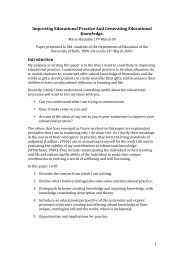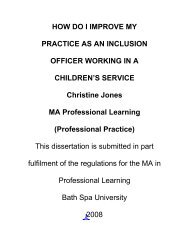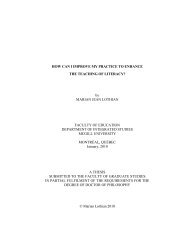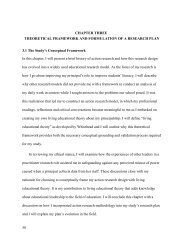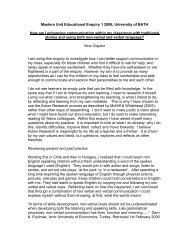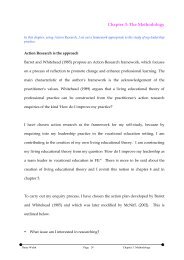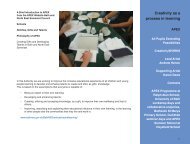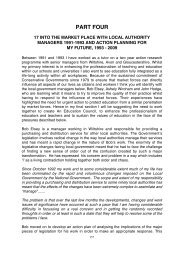def<strong>in</strong>itions from other paper??? or <strong>of</strong> human flourish<strong>in</strong>g? ASIDE: had adiscussion with Diccon about whether everyone’s values are <strong>in</strong>accordance with the greater good.It uses digital technology to ‘bridge divides <strong>of</strong> economic capital throughdigitally‐mediated education that connects rural and urban students(and/or teachers) to rich educational resources outside the classroomwalls’. (Tierney & Renn, 2012, p.2) A method <strong>of</strong> ‘empathetic resonance’us<strong>in</strong>g digital technology clarifies the mean<strong>in</strong>gs <strong>of</strong> the expression <strong>of</strong>embodied values and energy that contribute to the explanatory pr<strong>in</strong>ciples<strong>of</strong> educational <strong>in</strong>fluences <strong>in</strong> learn<strong>in</strong>g how to reduce <strong>poverty</strong> and createattitud<strong>in</strong>al, behavioural, and social transformational learn<strong>in</strong>gopportunities that bridge the divide <strong>in</strong> a way that challenges the statusquo <strong>of</strong> education.The presentation responds to the purpose <strong>of</strong> the theme <strong>of</strong> AERA 2013to signal that ‘we must engage and exam<strong>in</strong>e the complexities <strong>of</strong> <strong>poverty</strong>,as well as challenge oversimplifications <strong>in</strong> how we study and address<strong>poverty</strong> and its consequences.’ (Tierney & Renn, 2012, p.2). The work <strong>of</strong>these multi-age educational action <strong>research</strong>ers draws <strong>in</strong>sights from thetheories <strong>of</strong> education <strong>research</strong>ers and provides evidence <strong>of</strong> the use <strong>of</strong><strong>research</strong> to advance knowledge about education, <strong>of</strong> scholarly <strong>in</strong>quiry and<strong>of</strong> serv<strong>in</strong>g the public good (Ball and Tyson, 2011).The paper draws on the action <strong>research</strong> <strong>of</strong> students and teachers as theydevelop their ontological awareness <strong>of</strong> their liv<strong>in</strong>g theories thus creat<strong>in</strong>g aspace for a new epistemology to emerge and reduce the impoverishedstate <strong>of</strong> all stakeholders by recogniz<strong>in</strong>g and validat<strong>in</strong>g their alternativeways <strong>of</strong> be<strong>in</strong>g <strong>in</strong> this world and contribut<strong>in</strong>g to the academy and thegreater good.In this AERA 2013 paper, we will focus on the issue <strong>of</strong> the validity <strong>of</strong> themean<strong>in</strong>gs <strong>of</strong> the energy-flow<strong>in</strong>g values that as educators we use toexpla<strong>in</strong> our educational <strong>in</strong>fluences <strong>in</strong> our own learn<strong>in</strong>g and <strong>in</strong> the learn<strong>in</strong>g<strong>of</strong> others. In this paper we acknowledge the importance <strong>of</strong> Dadds andHart’s (2001) idea <strong>of</strong> methodological <strong>in</strong>ventiveness <strong>in</strong> which we aremak<strong>in</strong>g methodological choices about ways <strong>of</strong> achiev<strong>in</strong>g our purposes (p.169).2. PERSPECTIVESThe ma<strong>in</strong> perspective <strong>in</strong> this presentation is provided by Tierney andRenn (2012) <strong>in</strong> their call for submissions for AERA 2013 address<strong>in</strong>g
issues <strong>of</strong> <strong>in</strong>tellectual and moral <strong>poverty</strong>. They ask members <strong>of</strong> AERA for:...theoretical analyses as well as <strong>research</strong>-based arguments abouteducation and <strong>poverty</strong>. We desire studies about how educationalpolicies and practices might reduce <strong>poverty</strong>, as well assubmissions that <strong>in</strong>vestigate why educational policies andpractices <strong>of</strong>ten fail to address <strong>poverty</strong>. We seek papers that<strong>in</strong>troduce new methods for analyz<strong>in</strong>g education and <strong>poverty</strong>. Ourown assumption is that as educators we have an obligation towork with one another <strong>in</strong> a manner that enables not merelyanalysis, but also transformative change.One <strong>of</strong> the weaknesses <strong>in</strong> enhanc<strong>in</strong>g the spread <strong>of</strong> the educational<strong>in</strong>fluences <strong>of</strong> 'liv<strong>in</strong>g-educational-theories' <strong>in</strong> transcend<strong>in</strong>g <strong>constra<strong>in</strong>ts</strong> <strong>of</strong><strong>poverty</strong> could be related to the importance <strong>of</strong> <strong>in</strong>tegrat<strong>in</strong>g understand<strong>in</strong>gs<strong>of</strong> Delong’s idea <strong>of</strong> creat<strong>in</strong>g, susta<strong>in</strong><strong>in</strong>g and evolv<strong>in</strong>g 'cultures <strong>of</strong> <strong>in</strong>quiry'.While there are many evidence-based explanations from <strong>in</strong>dividualswork<strong>in</strong>g <strong>in</strong> particular sites (see -http://www.action<strong>research</strong>.net/writ<strong>in</strong>gs/mastermod.shtml ) that they have<strong>in</strong>fluenced their own learn<strong>in</strong>g and the learn<strong>in</strong>g <strong>of</strong> others, there are farfewer explanations that focus on the learn<strong>in</strong>g <strong>of</strong> social formations,especially <strong>in</strong> relation to overcom<strong>in</strong>g the <strong>constra<strong>in</strong>ts</strong> <strong>of</strong> <strong>poverty</strong>. We areprovid<strong>in</strong>g evidence to show that explanations <strong>of</strong> <strong>in</strong>fluence <strong>in</strong> the learn<strong>in</strong>g<strong>of</strong> social formations are needed to spread educational <strong>in</strong>fluences fromparticular <strong>in</strong>dividuals work<strong>in</strong>g <strong>in</strong> particular sites to global <strong>in</strong>fluences thatcan move between cultures and social formations. We are show<strong>in</strong>g howthis could be done by <strong>in</strong>tegrat<strong>in</strong>g <strong>in</strong>to our understand<strong>in</strong>gs and practicesthe idea <strong>of</strong> a 'culture <strong>of</strong> <strong>in</strong>quiry'. We see ourselves as ‘global citizens' <strong>in</strong>the sense <strong>of</strong> liv<strong>in</strong>g as fully as we can the values we believe carry hope forthe future <strong>of</strong> humanity.We want to be clear <strong>in</strong> the mean<strong>in</strong>gs <strong>of</strong> the words that we are us<strong>in</strong>g. Toclarify, then, by ‘social formations’ we mean our classrooms, our schools,our school systems, our communities, our societies and the Academy. Asexamples, for all <strong>of</strong> us, our classrooms and schools are social formations;for Jackie, her social formations have <strong>in</strong>cluded local school systems,communities and some global communities, such as Brazil and Japan; forJack, his social formations have <strong>in</strong>cluded local and many globalcommunities, such as <strong>in</strong> Croatia, Norway, Japan, Canada, The Republic<strong>of</strong> Ireland, and Africa; for Liz, her social formations <strong>in</strong>clude herclassroom and school as well as her classrooms <strong>of</strong> fellow PhD<strong>research</strong>ers; for Cathy, her social formations <strong>in</strong>clude her classroom andschool as well as the teachers a math project she is facilitat<strong>in</strong>g. For all <strong>of</strong>







